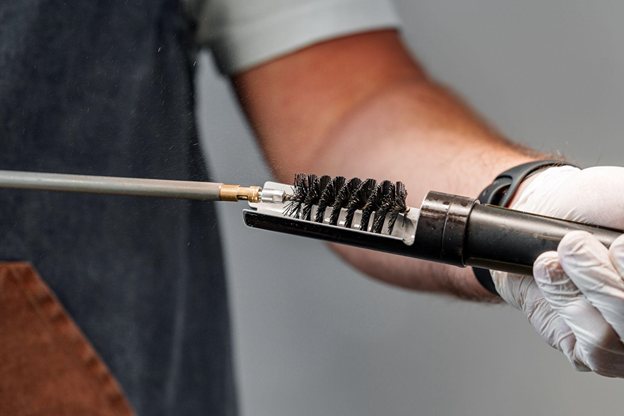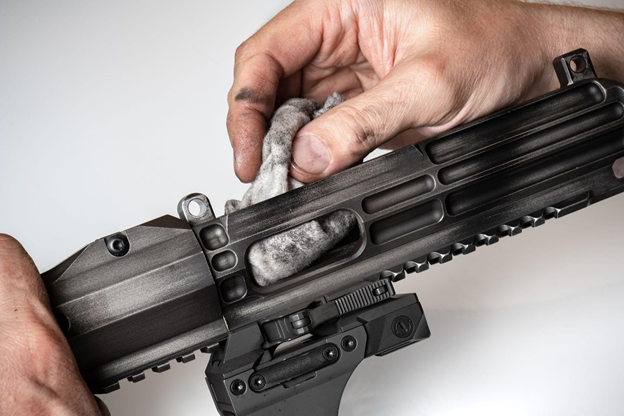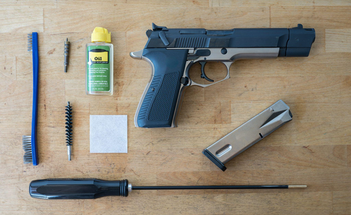Giving Your Gun a Quick Cleaning After the Range: High Level Notes
Jul 4th 2025
Break out the gun cleaning kit, we’re going to break down how to give your gun a quick cleaning after the range.
In recognition of the fact that firearms vary considerably in terms of action type and aspect, we’ll keep this as high-level as possible so as not to get lost in the details. With no further ado, let’s begin.
Cleaning the Bore

The most important thing here is safety. Before cleaning any firearm, make sure to drop the magazine (if applicable) and open and inspect the chamber physically and visually to ensure that the gun is clear.
Then, the first thing you’ll want to do, after every trip to the range, is clean your gun’s bore. Separate the barrel from the stock or if that’s inconvenient, open the action or remove the bolt out of the receiver so you can better access the barrel.
Break out the cleaning rod from your gun cleaning kit, along with a bronze brush that’s appropriate for the caliber in question. Either apply a few drops of a bore solvent like Hoppe’s No. 9 to the brush, or else dip the brush in the solvent.
Allow the excess to drip off, then pass the brush through the bore (from chamber to muzzle) several times. This will soak any fouling deposits in solvent and the mechanical action of the brush’s bristles will help loosen residue.
After a few passes, swap the bore brush for either a mop that’s appropriate for the caliber, or a slotted jag. Insert a clean patch into the jag and then pass either that (or the mop) through the bore from chamber to muzzle.
The first patch should come out more or less black. If the gun wasn’t very dirty to begin with, it should take a few passes to remove all of the fouling satisfactorily. Otherwise, you’ll want to run the brush through a bore again and repeat the process.
Once the patches come out clean, you can move onto the action.
Special Note for Rifled Bores: If you are cleaning a gun with a rifled bore, be it a long arm or a handgun, make sure that you clean from the breech to muzzle only, unless you use a bore guide at the muzzle. Contact with the muzzle’s crowning can cause damage which will adversely affect accuracy and you want to avoid this. The easy way to do so is always to remember to clean from chamber to muzzle.
Cleaning the Action
Depending on your gun, you may be able to remove either the bolt or bolt carrier from the receiver. In pump action shotguns and rifles, you should be able to remove the bolt carrier on the action bars. The bolts of bolt action rifles, as well as of gas sporting rifles, can usually be removed through the rear of the receiver.
Clean off the exterior of the bolt or bolt carrier using a nylon brush and some bore solvent if necessary, then make sure to remove any solvent residue from the surface. Using a can of compressed air, blast out the inside of the action to remove any loose dust or dirt.
Then, use a small nylon (or brass) brush to clean out any remaining fouling deposits inside the action. Once they’ve all been loosened, use either a clean patch or a microfiber rag to clean the inside surfaces of the action in the receiver.

After this has been done, you can apply a drop or two of gun oil to the bolt carrier group where it contacts the receiver, or to the action bars or rails on which the bolt/bolt carrier group rides. Remember, less is more, as oil will attract dust, dirt, and fouling.
Cleaning the Trigger Group
Lastly, if necessary, drop the trigger group and give it a cursory cleaning. This will not be necessary with every cleaning but should be performed from time to time.
If you have a trigger group that’s treated with an advanced nonstick coating like nickel-Teflon (or something similar) do not clean the trigger group with any solvent that will leave a residue.
Instead, use some compressed air and a solvent like Ronsonol lighter fluid that will dry completely clean and leave no residue. Then, once the trigger group is clean and dry, wipe off the exterior of the housing with a microfiber cloth (which should leave behind no fibers) and reinstall in the gun.
The Case for a Gun Cleaning Kit
That’s most of what there is to giving most guns a high-level cleaning after a day at the range, and if you don’t yet have a gun cleaning kit, here are a few good reasons to get one.
First, most gun cleaning kits will have all you need and more to render a basic cleaning, and there are some universal kits you can get that will enable you to service more than one type of platform.
Others are specialized to rifles, shotguns, or handguns, but in either case they’ll have all you need and more, in terms of a rod, brushes, jags, patches, and some even come with bore solvent and oil.
Moreover, since gun cleaning kits are bundled you can usually save a bit by buying them as opposed to getting all the components separately.
Either way, we sell cleaning kits as well as piecemeal gun cleaning essentials. Take a look through our collection and make sure you have what you need to restore your gun after you come back from the range, before you go.

